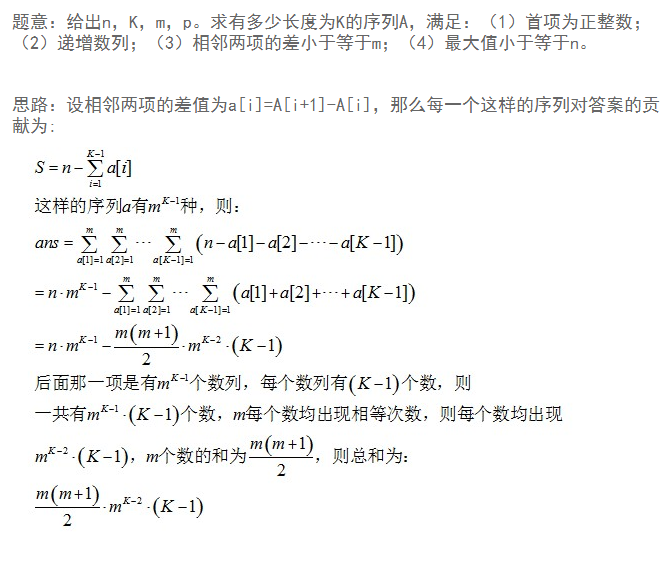Description
小 T最近在学着买股票,他得到内部消息:F公司的股票将会疯涨。股票每天的价格已知是正整数,并且由于客观上的原因,最多只能为N。在疯涨的K天中小T观察 到:除第一天外每天的股价都比前一天高,且高出的价格(即当天的股价与前一天的股价之差)不会超过M,M为正整数。并且这些参数满足M(K- 1)<N。
小T忘记了这K天每天的具体股价了,他现在想知道这K天的股价有多少种可能
Input
只有一行用空格隔开的四个数:N、K、M、P。对P的说明参见后面“输出格式”中对P的解释。
输入保证20%的数据M,N,K,P≤20000,保证100%的数据M,K,P≤109,N≤1018 。
Output
仅包含一个数,表示这K天的股价的可能种数对于P的模值。【输入输出样例】
Sample Input
7 3 2 997
Sample Output
16
【样例解释】
输出样例的16表示输入样例的股价有16种可能:
{1,2,3},{1,2,4},{1,3,4},{1,3,5}, {2,3,4},{2,3,5},{2,4,5},{2,4,6}, {3,4,5},{3,4,6},{3,5,6},{3,5,7},{4,5,6},{4,5,7},{4,6,7},{5,6,7}
【样例解释】
输出样例的16表示输入样例的股价有16种可能:
{1,2,3},{1,2,4},{1,3,4},{1,3,5}, {2,3,4},{2,3,5},{2,4,5},{2,4,6}, {3,4,5},{3,4,6},{3,5,6},{3,5,7},{4,5,6},{4,5,7},{4,6,7},{5,6,7}

1 #include<cstdio> 2 #include<cmath> 3 #include<iostream> 4 #include<algorithm> 5 #include<cstring> 6 #include<cstdlib> 7 #define ll long long 8 using namespace std; 9 10 ll m,n,k,p; 11 12 ll pow(ll a,ll b) 13 { 14 ll ans=1; 15 while(b) 16 { 17 if(b&1) ans=(ans*a)%p; 18 b>>=1; 19 a=(a*a)%p; 20 } 21 return ans; 22 } 23 int main() 24 { 25 scanf("%lld%lld%lld%lld",&n,&k,&m,&p); 26 if (k==1) 27 { 28 printf("%lld ",n%p); 29 return 0; 30 } 31 ll x=(n%p*pow(m,k-1))%p,y=((m*(m+1)/2)%p*pow(m,k-2))%p*(k-1)%p; 32 ll ans=x-y; 33 ans=(ans+p)%p; 34 printf("%lld",ans); 35 }